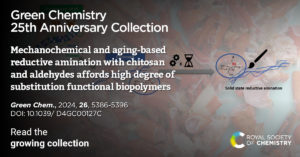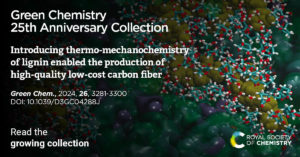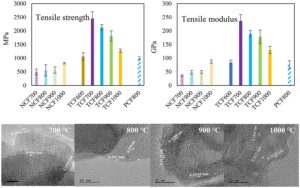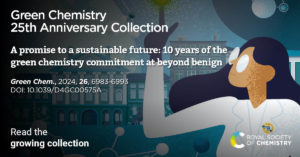Over the past 25 years, Green Chemistry has provided a unique forum for the publication of innovative research on the development of alternative sustainable technologies, efficient utilisation of resources and the concomitant minimisation of waste. We are delighted to bring together a very special issue containing articles by members of the green chemistry community as well as past and present Green Chemistry Board members, to mark and celebrate our first 25 years.
Among the contributions to this themed collection is a Paper reporting a mechanochemical and aging-based method to alkylate Chitosan via reductive amination (DOI: 10.1039/D4GC00127C).
Read our interview with Audrey Moores, one of the corresponding authors.
 Could you briefly explain the focus of your article to the non-specialists?
Could you briefly explain the focus of your article to the non-specialists?
Chitosan is an interesting material that can be extracted from crustacean waste and has antibacterial and biocompatibility properties. It has however limited solubility so it is very hard to modify its properties to meet our needs. Our group developed a way to functionalize it, and introduce new properties by reacting it in the solid-state giving easily access to, for instance, a more soluble version of chitosan.
How would you set this article in a wider context?
Nature is providing us with wonderful materials packed with amazing properties such as wood or crustaceans exo skeleton. Taking these materials and transforming them with simple and accessible chemistries is a great way for us to replace petrochemicals around us, but it is difficult to achieve because these materials are typically not soluble in most solvents. With this work not only do we demonstrate that working in the solid-state resolve this conundrum, but also we are able to achieve a higher degree of functionalization than similar chemistries in the liquid state.
What is the motivation behind this work?
Our group works in Quebec, which is one of the 13 provinces and territories of Canada. Quebec has an important fishery industry generating every year an estimated 40,000 tons of crustacean waste, currently unvalorised. We are developing a program to demonstrate that mechanochemistry and solid-state reactivity can provide a unique avenue for transforming this underutilized stream into functional materials useful for our societies.
What aspects of this work are you most excited about at the moment and what do you find most challenging about it?
This article is Clearly showcasing how mechanochemistry and solid-state reactivities could be a productive way to develop new products made from chitin, cellulose and chitosan.
What is the next step? What work is planned?
Our work is now geared towards new functionalization of this material so that we could expand our toolbox even further.
Please describe your journey to becoming part of the Green Chemistry community
Green Chemistry started for me during my post doc, which I did under the mentorship of Professor Robert Crabtree at Yale University close to 20 years ago. Back then, Bob sent me to the Green Chemistry summer school of the ACS in Washington. At that event, I met many people including Paul Anastas, Julie Zimmerman and Phil Jessop, all legendary names in the field, who have motivated me to become part of the community. When I started my group at McGill, as a Canada research chair in Green Chemistry, it was thus natural for me to teach this topic, do my research according to its principles, and an encourage all my trainees to become active members in the community.
Why did you choose to publish in Green Chemistry?
Green Chemistry remains a flagship for our community, as the first journal in the field. I have published many articles in this journal and always appreciate the quality of the work from the team and the wide readership it provides.
What do you think the Green Chemistry journal has done well in the past 25 years, and what do you think are the main challenges our community will face in the next 25 years?
Looking back, it is evident to me that Green Chemistry has been a key player in making this topic front and centre in the field of chemistry at large. Honestly this is something that was not evident 25 years ago, and it is thus a huge achievement in my opinion. I think our community should look at the 25 coming years to make sure it becomes central as a science. Working in the field of sustainability, I feel there is still room for people to realize the immense role that chemistry and especially green chemistry can play in developing it further.
Meet the corresponding author
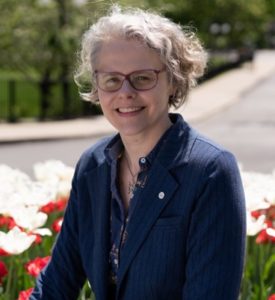 Audrey Moores is a professor of chemistry and associate director of the Facility for Electron Microscopy Research at McGill University. She completed her PhD at the Ecole Polytechnique, France and a post-doctoral fellowship at Yale University. She serves as an executive editor for ACS Sustainable Chemistry & Engineering. She became a member (2020) and president (2024-26) of the College of New Scholars, Artists and Scientists of the Royal Society of Canada. She received the Canadian Chemistry and Chemical Engineering Award for Green Chemistry (2021). With her group, she focuses on sustainable solutions for nanoparticles and biopolymer synthesis as well as catalyzed reactions, with an interest in waste biomass valorization, earth abundant starting materials and high atom economy and has been travelling globally to teach green and sustainable chemistry
Audrey Moores is a professor of chemistry and associate director of the Facility for Electron Microscopy Research at McGill University. She completed her PhD at the Ecole Polytechnique, France and a post-doctoral fellowship at Yale University. She serves as an executive editor for ACS Sustainable Chemistry & Engineering. She became a member (2020) and president (2024-26) of the College of New Scholars, Artists and Scientists of the Royal Society of Canada. She received the Canadian Chemistry and Chemical Engineering Award for Green Chemistry (2021). With her group, she focuses on sustainable solutions for nanoparticles and biopolymer synthesis as well as catalyzed reactions, with an interest in waste biomass valorization, earth abundant starting materials and high atom economy and has been travelling globally to teach green and sustainable chemistry


